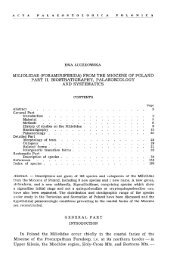The skull of Velociraptor - Acta Palaeontologica Polonica
The skull of Velociraptor - Acta Palaeontologica Polonica
The skull of Velociraptor - Acta Palaeontologica Polonica
Create successful ePaper yourself
Turn your PDF publications into a flip-book with our unique Google optimized e-Paper software.
ACTA PALAEONTOLOGICA POLONICA (44) (2)<br />
recess<br />
recess<br />
occipital condyler -. :%\ .W<br />
k7;:4,3i2?<br />
fenestra vestibularis + ";$-!:<br />
fenestra pseudorotunda I ot&phenoidal crest<br />
basisphenoid<br />
basisphenoid w<br />
Fig. 6. Schematic drawing <strong>of</strong> braincase in <strong>Velociraptor</strong> mongoliensis. A. Lateral view, GIN 100125.<br />
B. Dorsolateral view, GIN 100124. C. Rostral view, GIN 100124. I-V, VII - nerve exits. Not to scale. Drawn<br />
by K. Sabath.<br />
latter suture is continued by the parietal-prootic suture, which slopes ventrally towards the back <strong>of</strong><br />
the braincase. <strong>The</strong> caudal contact <strong>of</strong> the laterosphenoid is with the dorsal portion <strong>of</strong> the prootic along<br />
a distinct dorsoventral, zigzag suture. Just behind its contact with the laterosphenoid, the dorsal wing<br />
<strong>of</strong> the prootic bears a large, elongate depression. This depression is present in GIN 100125 and 24 and<br />
it probably represents the dorsal tympanic recess. <strong>The</strong> rostroventral contact <strong>of</strong> the laterosphenoid<br />
with the prootic is not clearly marked, and it is unknown how far rostrally this contact continues. <strong>The</strong><br />
otosphenoid crest is well pronounced. Below it, three openings pierce the prootic in GIN 100125. <strong>The</strong><br />
most rostral and dorsal one represents the exit <strong>of</strong> the trigeminal nerve; it is large, placed within a shal-<br />
low concavity (there is a pair <strong>of</strong> openings in this position on the left side <strong>of</strong> the braincase), and is<br />
bounded dorsally by the laterosphenoid and caudally by the prootic. A horizontal groove runs rostral<br />
to this opening, which might conduct the ophthalmic branch <strong>of</strong> the trigeminal nerve (Currie 1995).<br />
A vertical groove runs ventrally from the exit <strong>of</strong> the fifth nerve. Caudoventral to this opening, an-<br />
other, much smaller one is visible in GIN 100125. It is probably for the exit <strong>of</strong> the facial nerve. This<br />
opening is much larger in GIN 100124 and may represent the prootic recess (Witmer 1997b) which<br />
probably contained the exit <strong>of</strong> the facial nerve. <strong>The</strong> third <strong>of</strong> these openings is most ventral and most<br />
caudal in position. It is large and vertically elongated and may correspond to the fenestra vestibularis<br />
+ fenestra cochlearis. This opening seems to be bounded ventrally by a narrow tongue <strong>of</strong> the<br />
basisphenoid, rostrodorsally by the prootic and caudodorsally by the opisthotic. In GIN 100125, on<br />
the rostral surface <strong>of</strong> the paroccipital process and at its base, ventral and somewhat medially to the

















